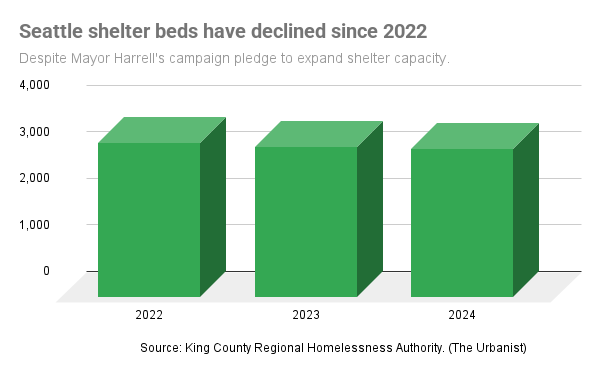
Sweeps have tripled under Mayor Harrell, but shelter capacity has shrunk, and the number of people who are unsheltered remains stubbornly high.
Walking around Seattle’s streets and parks, you might notice the tents are fewer and farther between than when Mayor Bruce Harrell took office a few years ago. You might think “Wow, Harrell is really making progress on homelessness!”
This week, Seattle Times reporter Greg Kim set the record straight. The reduction in visible homelessness during Harrell’s term is purely cosmetic. The reality is downright cruel, and it’s part of a cynical political strategy that assumes Seattle voters won’t notice or don’t care what’s really going on.
None of this should come as a revelation to anyone who’s been paying attention. The Urbanist and PubliCola have reported on Harrell’s failure to make good on his 2021 campaign promise to open 2,000 units of emergency housing or shelter in his first year. Guy Oron has documented Harrell’s escalating sweeps in Real Change News and on his website. But Kim’s piece weaves a powerful story around a few stark facts that are hard to run away from.
Finally, credit where credit’s due. @guyoron.net has been on the case, consistently documenting and reporting on Harrell’s escalating sweeps. gossipguy.net/seattle-swep…
— Katie Wilson (@wilsonkatieb.bsky.social) April 22, 2025 at 8:48 AM
[image or embed]
First, encampment removals, a.k.a. sweeps, have indeed risen to record levels under Harrell’s administration, with 2,505 conducted in 2024 – up from 800 in 2022. And they have results to show for it: the tent count is way down.
But don’t let that fool you. More people are living and sleeping unsheltered in Seattle today than ever before. As Seattle Times columnist Danny Westneat wrote in January, about 10,000 people, or 57% of our total homeless population, are living unsheltered in King County. That’s twice as many people unsheltered as New York City, six times as many as Chicago, and ten times as many as Philadelphia. Incredible. Yes, that’s countywide, but based on data from the Point in Time Count it’s likely that about 7,000 of these people are in Seattle.
Where are they sleeping, if not in tents? “To hide from the city’s escalating pace of encampment removals, homeless people say they are hiding deeper in the woods, where assaults, overdoses and emergencies can go unnoticed,” wrote Kim. Or they’re huddled in alleyways and doorways, with little protection from the elements.
The shelters we have are full. “At any point, 95% of beds are filled, with turnover accounting for some of the vacancy,” wrote Kim. And, shockingly, “Each year Harrell has been in office, Seattle has lost shelter beds.” They’re not even trying.

Harrell has made his choice: instead of spending money to get people inside, he’s spending money to make life harder, more precarious, and more dangerous for the thousands who are suffering on Seattle’s streets. Sweeping human beings to oblivion.
Is this the “compassion” that Bruce Harrell and (now deputy mayor) Tim Burgess promised us four years ago? The emperor has no clothes. This is naked cruelty.
This also speaks to a particular political strategy. Harrell is betting that Seattle voters are truly callous, or at least easily deceived. That we don’t care what happens to our homeless neighbors, so long as they aren’t visible. Out of sight, out of mind.
Let’s prove him wrong.
I’m challenging Bruce Harrell in this year’s election for Seattle Mayor because I know we can do better. We can open new shelter beds. We can rapidly reduce unsheltered homelessness and misery by providing the care that people need, in dignified settings — not leaving people in the streets or moving them around endlessly. We know what works. What’s lacking is the political will to bring solutions to scale. Join me and let’s make real progress.
Katie Wilson is General Secretary of the Transit Riders Union, a Seattle-based organization advocating for improving transit quality and making access more equitable. In 2025, she launched a run for Seattle Mayor.


